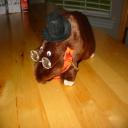Yahoo Answers is shutting down on May 4th, 2021 (Eastern Time) and beginning April 20th, 2021 (Eastern Time) the Yahoo Answers website will be in read-only mode. There will be no changes to other Yahoo properties or services, or your Yahoo account. You can find more information about the Yahoo Answers shutdown and how to download your data on this help page.
Trending News
5 Answers
- kbLv 74 years agoFavorite Answer
Apply L to both sides (letting Y(s) = L{y}):
L{dy/dt} = L{1 - y}
==> s Y(s) - y(0) = L{1} - L{y}
==> s Y(s) - 4 = 1/s - Y(s).
Solve for Y(s):
(s + 1) Y(s) = 4 + 1/s = (4s + 1)/s
==> Y(s) = (4s + 1)/(s(s + 1))
==> Y(s) = 1/s + 3/(s + 1), by partial fractions.
Inverting yields y(t) = 1 + 3e^(-t).
I hope this helps!
- MyRankLv 64 years ago
3. dy/dt = 1-y
L{dy/dt} = L{1-y}
Sy(s)-y(0) = L{1} – L{y}
(∵ f’(t)=sf(s)-f(0))
(∵ L{1} = 1/5)
y(s)(1+s) = 1/5+4
y(s) = 1+4s/s(1+s)
y(s) = A/s + B/(5+1)
y(s)=1/5+3/5+1
L-1{y(s)} = 1+3e-t
Source(s): http://myrank.co.in/ - ComoLv 74 years ago
∫ dy / [ 1 - y ] = ∫ dt
- log [ 1 - y ] = t + C
log [ 1 - y ] = K - t
1 - y = e^(K - t)
y = 1 - e^(K - t)
- How do you think about the answers? You can sign in to vote the answer.



